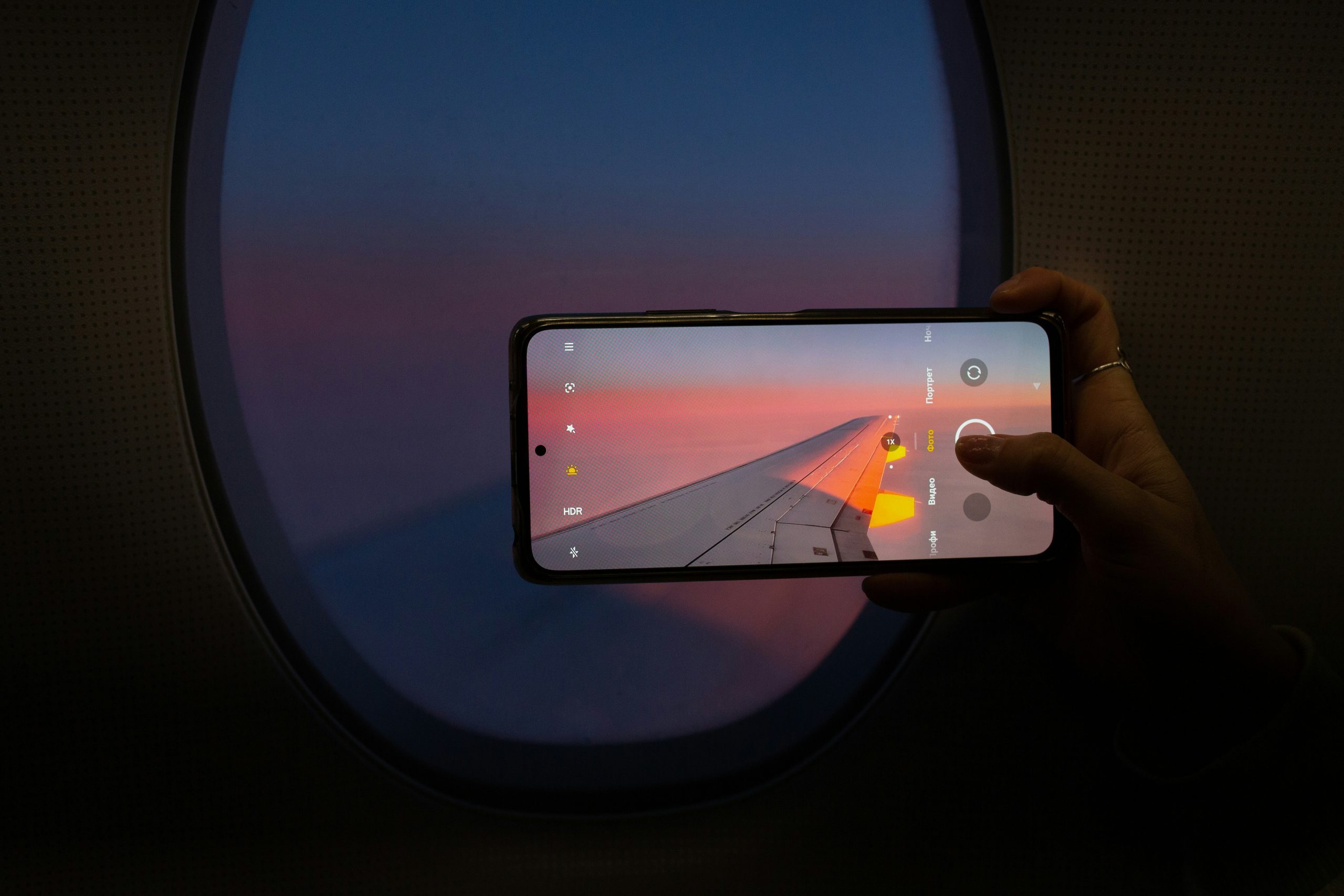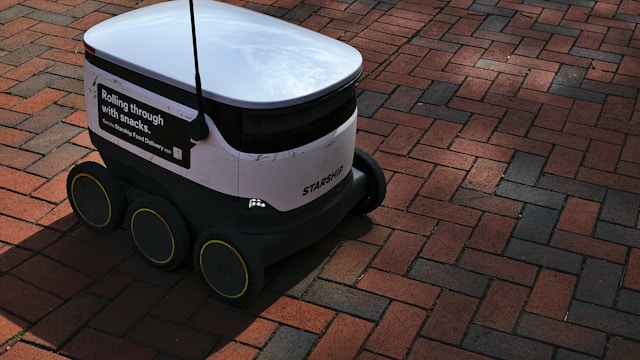

If you click affliate links on our website, we may earn a commission at no extra cost to you.
The way we buy and get our stuff has changed. Matching new consumer behaviour with robotic delivery seems the logical conclusion of convenience and logistics, with a touch of sci-fi magic. (What could go wrong!) Combine the growth in ecommerce shopping trends with the unstoppable momentum of automation and, well, your next bag of groceries or prescription meds might arrive in a cargo pod on six wheels or drop onto your doorstep via a delivery drone.
But not all delivery robots are created equal. Some deliver pizza. Others drop off insulin. Some get stuck on curbs. Some don’t.
Who’s really winning this delivery robot arms race? If the main contenders were put into the famous BBC One show arena of Robot Wars and made to battle to the death, which would be the last bot standing?
Starship Technologies
The Estonian-born company is probably the first name you think of when someone says “delivery robot.” Their cute, cooler-sized bots with their blinking lights and low hum have been a familiar sight on American college campuses and European sidewalks since around 2018. Starship has carved out a niche for short-distance, low-weight deliveries—think snacks, groceries, or a bottle of wine on a Thursday night.
Their tech is relatively mature. The robots are fully autonomous (though remote human assistance is available), navigate using computer vision, radar, and GPS, and boast a delivery success rate that hovers above 99%. They’re quiet, electric, and environmentally light-touch. However, they’re not fast. But that’s kind of the point. You don’t need a grocery order delivered in five minutes; you just want to know it’ll get to you without drama.
Customer feedback is mostly positive. People enjoy the novelty, and students in particular treat the bots like little mascots. That said, there have been occasional issues—blockage on sidewalks, interactions with pedestrians (and pets), and concerns about accessibility. But these are minor hiccups in what is arguably the most polished system in the consumer delivery space.
Amazon Prime Air
Amazon’s drone delivery division is the punchline that became prophecy. Long the stuff of keynote speeches and Super Bowl ads, Prime Air is now actually operational in a few test cities in the U.S., notably Lockeford, California and College Station, Texas. It was announced in January 2025 that the first UK based trial of Prime Air deliveries would take place from the distribution centre in Darlington, County Durham.
The drones themselves are technically impressive. VTOL-capable (vertical take-off and landing), they fly at altitudes up to 400 feet and can carry packages under five pounds (2.2 KG). A bit limited, sure, but enough for the average ecommerce order. Navigation is managed via a mix of onboard sensors, machine learning, and GPS, with a focus on minimizing risk to people and pets.
Reactions have been mixed. There’s awe, of course—who wouldn’t be impressed seeing a flying robot descend with your USB-C cable or vitamin supplements? But there’s also skepticism. Noise, privacy concerns, and the dreaded “what if it falls on my kid’s head?” question. Still, Amazon has the scale and the cash to iterate, and the future of airborne delivery may very well be shaped by how well they stick the landing here.
Serve Robotics (formerly Postmates X)
Spawned from Postmates and then absorbed into Uber’s ecosystem, Serve Robotics operates a sidewalk robot service that looks like a Pixar character brought to life. These bots are designed for short, urban deliveries and are already live in parts of Los Angeles and San Francisco.
Serve’s strength is its integration. Tied into Uber Eats, the service blends seamlessly into existing consumer habits. The robots use a mix of sensors—LiDAR, GPS, ultrasonic—to navigate and avoid obstacles, and are generally supervised by remote operators who can intervene if needed.
The public seems charmed but occasionally confused. While Serve is praised for reducing emissions and traffic, people do sometimes find the bots a little too slow or tentative in complex urban environments. That said, they rarely cause real problems, and the branding is undeniably cute. It matters more than you’d think. (We’re all charmed by Wall-E and afraid of the Terminator T-1000, right?) Making delivery bots seem ‘friendly’ is certainly helpful for public perception and acceptance of what can seem like an intrusive technology to some.
Nuro
This is where things get a bit more automotive. Nuro doesn’t do small sidewalk bots. They make full-on autonomous delivery vehicles that drive on roads, complete with cameras, radar, and enough processing power to map a small city. Backed by heavyweights like SoftBank and Google’s parent Alphabet, Nuro is already delivering groceries and pharmaceuticals in parts of Texas and California.
Unlike its smaller cousins, Nuro’s vehicles can carry much larger loads. That makes them perfect for retail partners like Kroger or CVS. The customer experience is slick: order, get notified, walk out to a sleek robot van, punch in a code, and retrieve your stuff.
The biggest friction point? Regulation. Nuro operates under strict permits and often only in geofenced areas. But when it works, it works beautifully. And compared to a gas-powered delivery truck, the environmental footprint is much smaller. These things are electric, efficient, and surprisingly good at not crashing.
Cartken
Cartken is one of those companies that seems small until you realize who they’re working with. Partners like Uber Eats and Mitsubishi have helped deploy Cartken bots across college campuses and in select urban areas.
The robots themselves are compact, camera-heavy, and built to navigate without LiDAR (a cost-saving move). They excel in campus-like environments, where the terrain is relatively predictable and pedestrian-dense.
Reception has been quietly positive. These bots aren’t flashy, but they’re reliable, power-efficient, and easy to scale. Their lack of noise and low power consumption makes them a non-issue environmentally. Not sexy, exactly, but solid. Like the Toyota Corolla of delivery robots.
Kiwibot
Founded in Colombia and headquartered in the U.S., Kiwibot has an international edge. Their small, wide-eyed delivery bots are operating in over 25 cities, including major university towns.
Kiwibot takes a hybrid approach to autonomy: the robots handle basic movement on their own, but are monitored and remotely assisted by human operators based in lower-wage markets. It’s controversial, but effective.
User reviews are mostly good, though there have been stories of bots getting stuck or even catching fire (once, dramatically, in 2019). Kiwibot has since reworked its design and safety systems, and now emphasizes its commitment to clean tech and accessibility.
The Medical Frontier
Beyond burritos and impulse buys, delivery robots are making quiet but meaningful strides in medicine. One of the most talked-about players here is Zipline, the Rwandan-born company that now operates globally, including in the U.S. and Japan.
Zipline uses fixed-wing drones with parachute drop systems to deliver blood, vaccines, and critical medications to remote or hard-to-reach areas. It’s not flashy work, but it’s life-saving. The impact in sub-Saharan Africa has been immense, slashing delivery times from hours to minutes and helping to stabilize supply chains for rural clinics.
Other players include Matternet, which focuses on hospital networks in Switzerland and the U.S., and Wing, which has dabbled in healthcare logistics during emergencies. These systems aren’t as visible as sidewalk bots, but their stakes are higher. And interestingly, they often face less public resistance. When a robot brings you insulin instead of iced coffee, people seem less concerned about noise.
So… who’s winning?
Hard to say, really. Starship feels the most polished. Amazon has the biggest war chest. Nuro has scale. Zipline might have the most moral weight. It’s not a straight competition so much as a loosely connected set of experiments, all exploring the same idea: can technology make delivery radically better?
The answer so far? Sometimes. But with fewer emissions, fewer delivery vans jamming up our streets, and the kind of logistical elegance that would make a FedEx exec tear up, the trend is clear. The robots aren’t coming. They’re already here and they might soon be delivering your lunch.
Get notified about new articles